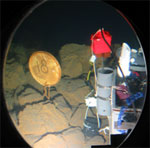Researchers Discover an Unexpected Source of Energy for Deep-sea Microbial
Communities
summary written by Raven Hanna
New rock formed by deep undersea volcanoes does not stay bare long. Microbes quickly move onto these basalts to form communities in the form of biofilms. As these biofilms grow and develop, they change the geology of their environment, forming mineral deposits. Since many of these communities are deep in the cold ocean waters, where sunlight does not reach, they must use alternative sources of energy. What these might be is unknown, but a common theory posits that the microbes may be obtaining energy using materials from the rock itself.
To test this theory, that the microbes are dissolving the basalts for energy, a group of researchers led by Alexis Templeton and students at the University of Colorado in Boulder investigated the microbial communities near the Big Island of Hawaii. They used deep-sea submersibles to collect recently formed basalt samples to determine if the associated microbes catalyze the release of specific elements such as iron and manganese. They solved the problem of detecting chemical changes in minute quantities of these metals by using SSRL Beam Lines 2-3 and 11-2 to collect synchrotron-based x-ray fluorescence microprobe mapping and x-ray absorption spectroscopy data. They compared these spectroscopic results with electron microscopic imaging to reveal where certain elements were concentrated.
The researchers were surprised at their results that suggest that the microbes are not gaining their energy from dissolution of the basalts. Instead, the data suggest that the microbes are dependent on materials from hydrothermal vents that diffuse in the deep ocean. Additionally, the researchers found that these microbial communities are forming the precursors to ferromanganese crusts, which are widespread on the ocean floor but are of previously unknown origin. This research was published in the December 2009 issue of Nature Geoscience.
To learn more about this research see the full Scientific Highlight
Templeton, A.S., Knowles, E.J., Eldridge, D.L., Arey, B.W., Dohnalkova, A., Webb, S.M., Bailey, B.E., Tebo, B.M., Staudigel, H.S., 2009, A seafloor microbial biome hosted within incipient ferromanganese crusts. Nature Geoscience v. 2, p. 872-876.


